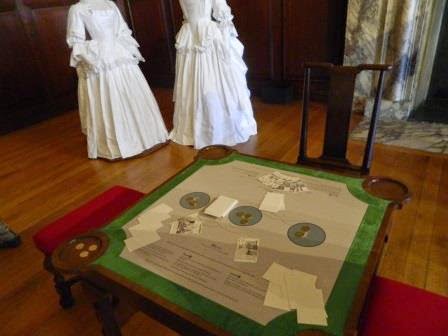 |
| Thomas Rowlandson: 'A Gambling Table at Cavendish House' |
‘A thousand meadows
and cornfields are staked at every throw, and as many villages lost as in the
earthquake that overwhelmed Herculaneum and Pompeii.’
Horace Walpole.
The Georgian era heralded many changes in society, including
the blossoming of leisure activities. It was an era when the aristocracy
liked to show off their wealth, to entertain and hold house parties. At the
latter, card games were especially popular and the host would set up tables for
guests to play faro, quadrille, piquet or whist. But where there was gaming,
there were wagers to be made, and money to be won or lost. For those less
scrupulous members of society, cheating was one option to get-rich-quick.
 |
| The Drawing Room in the Queen's State Apartments, Hampton Court Palace. Note the gaming table on the right |
Dice were an integral part of many games, and key to
cheating. Most of us have heard the expression, ‘loaded dice’, meaning that the
dice have been tampered with so as to land a specific way up. Also known as
‘gourds’, these were altered dice were the stock in hand of cardsharps or
‘blacklegs’ (more them in another post.)
To make a gourd, a die was partially hollowed out and
mercury added, so that when thrown, the die favored either low, or high,
numbers. Dice that always threw a low number were known as low-fullams, and
those high, as high-fullams. The latter
term goes back to Elizabethan times and the London suburb of Fulham, where all
the most notorious cardsharps liked to gather.
Another method of cheating was with bristle-dice. These
involved making a die with a short, firm bristle in one corner, such that when
the die was thrown, it couldn’t settle on that corner and tip over. The
technique is described in some detail, but Charles Cotton, in The Complete Gamester
(1726)
‘By Bristle-Dice,
which are fitted for that purpose, by sticking a hog’s bristle so in the
corners, or otherwise in the Dice, that they shall run high or low as they
please; this Bristle must be stonrg and short, by which means the Bristle
bending, it will not lie of that side, but will be tript over.’
.jpg) |
| Are black cats unlucky? That'a a whole different blog post! |



I hope you didn't pick up any bad habits visiting there!
ReplyDeleteMost definitely not! Had a wonderful day though, beautiful sunshine, excellent company and a stunning setting :-)
DeleteThanks for stopping by.
G x
Fascinating -- I've always wondered how loaded dice were made. How did they hide the hole where they'd hollowed the die out to put the mercury in? Were the dice made of wood? Or what? (I don't expect you to know the answers...I just have lots of questions!!) Thanks for a great post.
ReplyDeleteThese are all very good questions, Barbara. It must have taken a lot of craftsmanship to load a dice and then hide the evidence. I imagine a dice with a false side, that was then glued in place. But quite how you hid the join is beyond me.
DeleteG x